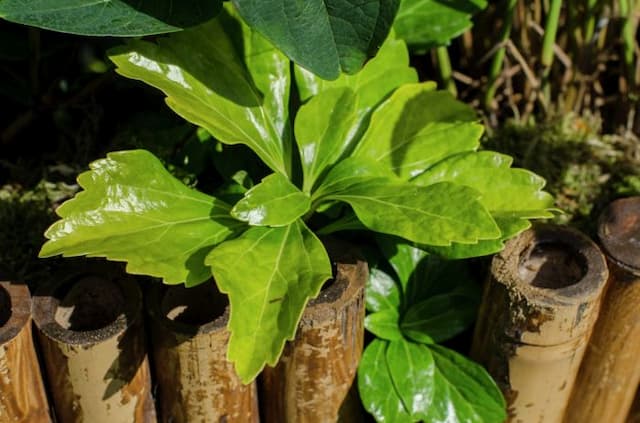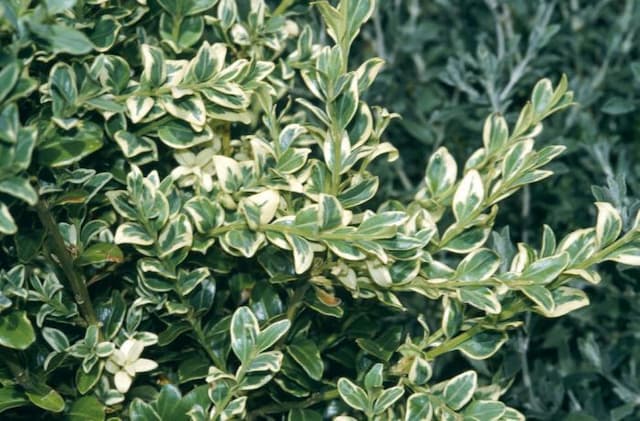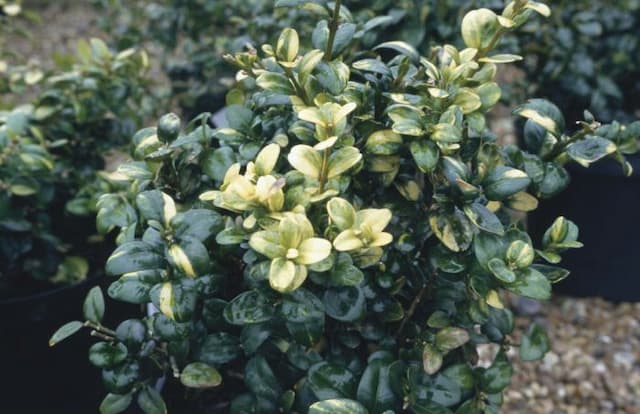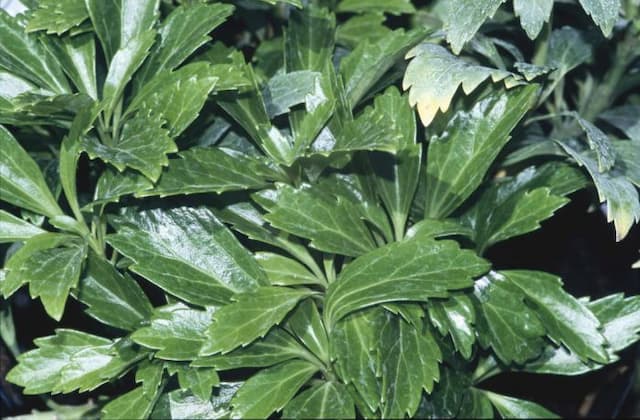Sweetbox Sarcococca confusa

ABOUT
Commonly known as Sweet Box, Sarcococca confusa is a dense, evergreen shrub that is known for its glossy, dark green leaves that are elongated and pointed at the tips, providing a lush backdrop throughout the year. The leaves commonly possess a leathery texture and are arranged in an alternate fashion along the branches. During late winter to early spring, Sweet Box produces small, creamy-white, extremely fragrant flowers that are quite inconspicuous against the dark foliage, but their sweet scent is evident even from a distance. Following the flowering period, this plant bears glossy black berries, which contrast starkly with the foliage, and can attract birds and other wildlife to the garden. These berries provide visual interest into late summer or fall. Overall, Sweet Box is appreciated in gardens for its year-round visual appeal and the delightful fragrance of its tiny blossoms.
About this plant
 Names
NamesFamily
Buxaceae.
Synonyms
Sweet Box, Christmas Box, Sweet Balsam, Fragrant Sarcococca.
Common names
Sarcococca confusa.
 Toxicity
ToxicityTo humans
Sweet Box is generally considered non-toxic to humans. However, consumption of any plant material can potentially cause discomfort or an adverse reaction in certain individuals. It is always recommended to avoid ingesting parts of ornamental plants as a precaution.
To pets
Sweet Box is also not commonly known to be toxic to pets. Nevertheless, it is best to prevent pets from eating plants as a precautionary measure since digestive upset or an unforeseen allergic reaction could occur if pets consume plant parts.
 Characteristics
CharacteristicsLife cycle
Perennials
Foliage type
Evergreen
Color of leaves
Green
Flower color
White
Height
3-5 feet (0.91-1.52 meters)
Spread
3-5 feet (0.91-1.52 meters)
Plant type
Shrub
Hardiness zones
7
Native area
China
Benefits
 General Benefits
General Benefits- Evergreen Foliage: Sarcococca confusa, commonly known as Sweet Box, provides year-round greenery and structure in gardens.
- Fragrant Flowers: Sweet Box produces highly fragrant flowers that can add a pleasant scent to the garden, particularly noticeable in the winter months.
- Shade Tolerant: This plant thrives in full to partial shade, making it ideal for understory planting or shady garden spots.
- Low Maintenance: Sweet Box requires minimal care once established, with little need for pruning or fertilizing.
- Dense Growth: Its bushy growth habit creates a dense screen, providing privacy and noise reduction in garden settings.
- Drought Tolerant: Once established, it is relatively drought tolerant, requiring less watering compared to other plants.
- Berries for Wildlife: The black berries produced are attractive to birds and other wildlife, providing a source of food and encouraging biodiversity.
- Landscape Versatility: It can be used in a variety of landscape applications, including borders, foundation plantings, and as ground cover.
- Soil Adaptability: Sweet Box can adapt to a range of soil types, albeit preferring moist, well-drained soils.
- Resistant to Pests: It is generally resistant to pests and diseases, reducing the need for chemical treatments.
 Medical Properties
Medical PropertiesThis plant is not used for medical purposes.
 Air-purifying Qualities
Air-purifying QualitiesThis plant is not specifically known for air purifying qualities.
 Other Uses
Other Uses- Sarcococca confusa, commonly known as Sweet Box, can be used as a privacy hedge due to its dense and bushy growth habit, creating a natural green barrier for homes and gardens.
- As a natural pest repellent, Sweet Box can be planted near patios and seating areas as its strong fragrance is believed to deter certain insect pests.
- The dense root system of Sweet Box makes it an effective plant for stabilizing soil on slopes and preventing soil erosion in landscape settings.
- Sweet Box is sometimes used in topiary art, as it can tolerate heavy pruning and can be shaped into various forms while maintaining its lush appearance.
- Due to its compact size and tolerance for shade, Sweet Box is a suitable plant for underplanting in woodland gardens, creating a textured understory beneath taller trees.
- In floral arrangements, the cut stems of Sweet Box with its glossy green leaves and fragrant flowers are used as foliage fillers to add volume and scent.
- During the holiday season, Sweet Box branches are used in making natural Christmas wreaths and garlands due to their evergreen nature and pleasant fragrance.
- The wood of Sweet Box is sometimes crafted into small wooden objects or turned into specialty charcoal for artistic use because of its fine-grain texture.
- Gardeners may use Sweet Box plants to create a sensory garden due to their fragrant flowers, which provide an olfactory experience year-round.
- In religious ceremonies or spiritual practices, the aromatic flowers of Sweet Box may be used as natural offerings or for creating a calming ambiance during rituals.
Interesting Facts
 Feng Shui
Feng ShuiThe Sweet Box is not used in Feng Shui practice.
 Zodiac Sign Compitability
Zodiac Sign CompitabilityThe Sweet Box is not used in astrology practice.
 Plant Symbolism
Plant Symbolism- Strength: Sarcococca confusa, commonly known as Sweet Box, has a robust and resilient nature, symbolizing inner strength and the ability to withstand harsh conditions.
- Protection: This evergreen plant with thick, glossy leaves represents protection and is often planted near homes for its safeguarding energy.
- Perseverance: Sweet Box has the ability to thrive in the shade, underlining a symbolism of perseverance and growth despite adversity.
 Water
WaterSweet Box prefers consistently moist soil, so water it regularly but avoid waterlogging. Generally, watering once a week with approximately half a gallon of water is sufficient, although this may vary depending on climate and soil drainage. During dry spells or in particularly hot weather, the frequency may need to increase to twice a week. However, in cooler months or when rainfall is abundant, watering can be reduced. Always ensure the top inch of soil is dry before watering again to prevent root rot.
 Light
LightSweet Box thrives in partial to full shade, making it an ideal plant for shadowed areas of the garden where other plants may struggle. This plant does best in a spot that is shielded from the harsh afternoon sun, which can scorch its leaves. A location under the canopy of larger trees or on the north side of a building is typically the perfect spot for Sweet Box.
 Temperature
TemperatureSweet Box is hardy and can tolerate a range of temperatures but prefers a cooler climate. It can withstand winters in zones 6 to 9, which translates to minimum temperatures of about -10 to -0 degrees Fahrenheit. The ideal temperature range for Sweet Box is between 60 to 70 degrees Fahrenheit during the growing season, while it remains remarkably resilient in colder winter weather.
 Pruning
PruningSweet Box should be pruned to maintain its shape and encourage bushier growth. Prune in late winter or early spring before new growth starts, which is also the best time to remove any damaged or diseased branches. It doesn’t need heavy pruning; just shaping and thinning out will keep it looking its best. Typically, pruning every couple of years is sufficient unless the plant is being used as a hedge or in formal gardens where more frequent pruning may be necessary to maintain a specific shape.
 Cleaning
CleaningAs needed
 Soil
SoilSweet Box prefers moist, well-drained soil mixed with compost and organic matter. The best soil pH for this evergreen shrub is slightly acidic to neutral, ranging from 6.0 to 7.0. A mixture of two parts garden soil, one part well-rotted compost, and one part perlite or sand can create an ideal environment for Sweet Box. Adjusting pH with sulfur or limestone may be necessary to maintain the optimal range.
 Repotting
RepottingSweet Box is typically a slow-growing plant and does not need to be repotted frequently. It can be repotted every 2-3 years or when the plant has outgrown its current container. Ensure the new pot has adequate drainage and is only slightly larger than the previous one.
 Humidity & Misting
Humidity & MistingSweet Box thrives best in moderate to high humidity environments. It prefers humidity levels between 50% and 70%, which closely replicate its natural understory habitat. Avoid placing it in excessively dry conditions or near heat sources which can reduce humidity levels.
 Suitable locations
Suitable locationsIndoor
Place Sweet Box near a window with filtered light and ensure high humidity.
Outdoor
Plant Sweet Box in shaded areas with moist, well-drained soil.
Hardiness zone
7-9 USDA
 Life cycle
Life cycleSarcococca confusa, commonly known as Sweet Box, starts its life cycle as a seed, which germinates in favorable conditions of moisture and temperature, typically in shaded areas. The seedling grows slowly, developing a robust root system and evergreen foliage, with the plant preferring a sheltered position and well-drained soil. As it matures into a bushy shrub, it produces dense, glossy leaves and, in late winter to early spring, tiny but highly fragrant white flowers emerge, providing winter interest and fragrance. Following pollination, which is often aided by insects, the flowers develop into small, spherical, glossy black berries that may persist into the following winter. These berries contain seeds that, once dropped or dispersed, can give rise to new plants, continuing the species' growth cycle. Over time, Sweet Box can form dense clumps and may require occasional pruning to maintain a desired shape and to promote healthy growth and flowering.
 Propogation
PropogationPropogation time
Early spring
Sweet Box, commonly known as Sarcococca confusa, is propagated by semi-ripe cuttings during the late summer months. Most gardeners find this method both practical and successful. To propagate by cuttings, one would cut a piece of the stem that has a few leaves and is about 4 to 6 inches (10 to 15 cm) long. This stem piece should be semi-ripe, which means it's from the current year's growth but has had time to partly harden. The lower leaves are stripped off, and the cut end may be dipped in rooting hormone to encourage root development. The cutting is then placed in a pot filled with a mix of peat and perlite or sand, ensuring the environment is kept humid and in indirect light. Roots typically form in a few weeks, after which the new Sweet Box plant can be transferred to a larger pot or directly into the garden.









